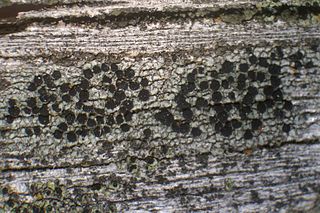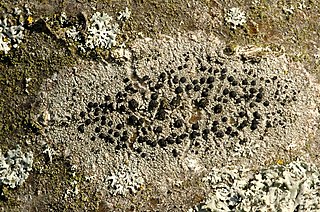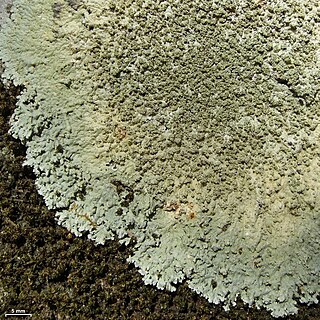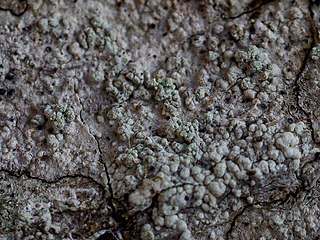
Buellia is a genus of mostly lichen-forming fungi in the family Caliciaceae. The fungi are usually part of a crustose lichen. In this case, the lichen species is given the same name as the fungus. But members may also grow as parasites on lichens (lichenicolous). The algae in the lichen is always a member of the genus Trebouxia.
Xanthoparmelia maricopensis, the Maricopa rock-shield, is a 2–6 cm (0.8–2.4 in) wide, yellow-green foliose lichen in the Parmeliaceae family. It grows on igneous rock in southwestern North American deserts.

Candelariella vitellina is a common and widespread green-yellow to orange-yellow crustose areolate lichen that grows on rock, wood, and bark, all over the world. It grows on non-calcareous rock, wood, and bark.

Lobothallia alphoplaca, the variable sunken disk lichen, is a creamy gray to brown, placodioid areolate lichen that grows on rock in on rock and sometimes moss. It prefers growing on siliceous rocks. It is found in Europe, central Asia, and North America, where it grows in the southwestern deserts to central California. The center has numerous crowded and deformed apothecia with rims of thallus-like tissue (lecanorine). With dark reddish or grayish brown to black discs. Lichen spot tests on the thallus and apothecia are C−, and KC−, with tests on the cortex K+ red, P+ orange, or K−, P− and on the medulla K+ red, and P+ orange. It produces norstictic acid, constictic acid, or salazinic acid as secondary metabolites.

Aspicilia cinerea is a gray to almost white, 1.5–15 cm (0.59–5.91 in) wide, crustose areolate lichen with large apothecia that mostly grows on rock in the mountains. It grows in variable forms, from having a continuous surface to being areolate. It grows in Eurasia, and North America on siliceous rock, schist or igneous rock in habitats exposed to sunlight, also rarely on calciferous rock. It is common in Arizona, and rare in California and Baja California at elevations of 1,700 to 3,300 metres.

Aspicilia pacifica is a white to grayish, brownish, or ocher crustose areolate lichen that commonly grows on siliceous rock or basalt along the seashore and in higher coastal mountains of California and Baja California. It has numerous small (0.1–.8 mm), round to angular apothecia toward the middle of the thallus, with concave to flat black discs that are sometimes lightened with white pruina. Lichen spot test on the cortex and medulla are I−, K+ yellow to red, P+ orange, and C−. Secondary metabolites include much stictic acid, and some norstictic acid.

Buellia disciformis, the boreal button lichen, is a thin, bluish to pale gray rimose to areolate crustose lichen that grows on bark in temperate forests in the northern USA and Europe, and at high altitudes in Arizona, down to 500 metres (1,600 ft) in coastal areas of California. Flat apothecia with black discs are .2-.7 mm in diameter and sessile, with noticeable lecideine margins. Lichen spot tests are negative except for K+ yellow. Secondary metabolites include atranorin, fulgidin, and sometimes traces of fulgoicin and norfulgoicin. B. erubescens is similar and more often found on wood than the bark loving B. disciformis, and has smaller spores.

Xanthoparmelia lineola, commonly known as the tight rock-shield, is a foliose lichen species in the genus Xanthoparmelia. It is a common species with a temperate distribution. Found in North America and South Africa, it grows on rocks.
Thomas Hawkes Nash III is an American lichenologist. His research is about the biology and ecology of lichens, and the effects of air pollution on plants and lichens. He is known as an authority on the family Parmeliaceae. During his long career at the Arizona State University, he helped develop the lichen herbarium into a world-class collection with over 100,000 specimens representing more than 5000 species. In 2010, the year of his retirement, he was awarded the Acharius Medal for lifetime achievements in lichenology, and the following year had a Festschrift published in his honor.
Punctelia cedrosensis is a species of foliose lichen in the family Parmeliaceae. It is endemic to Mexico, where it grows on the bark of conifers.
Harpidiaceae is a small family of lichen-forming fungi, containing two genera and five species. It is of uncertain classification in the Pezizomycotina.
Buellia subalbula is a species of saxicolous (rock-dwelling), crustose lichen in the family Caliciaceae. It occurs in coastal southern Africa, South America, and Australia, where it grows on calcareous rocks.

Buellia oidalea is a species of crustose lichen found along the Pacific coast of North America, from Coos County, Oregon to Baja California Sur.
Buellia stellulata, commonly known as the disc lichen) is a species of crustose lichen that is widely distributed throughout the Northern Hemisphere.

Dirinaria aegialita is a species of foliose lichen in the family Caliciaceae. It is found in tropical regions around the world, with scattered occurrences in subtropical North America.
Dirinaria neotropica is a species of lichen belonging to the genus Dirinaria within the family Caliciaceae. It was described by Kalb in 2004.

Dirinaria confluens is a species of foliose lichen belonging to the genus Dirinaria within the family Caliciaceae. It was originally described by D.D.Awasthi in 1975.
Dirinaria frostii is a species of lichen in the family Caliciaceae. It is commonly found in the southeastern United States and Sonora, Mexico. The species was first described by Tuckerman and later classified by Hale & Culberson.

Buellia griseovirens is a species of lichen belonging to the family Caliciaceae. It exhibits a crustose growth type and is commonly found on well-lit, smooth bark, and worked timber surfaces. The species can tolerate moderate pollution.

Buellia aethalea is a species of lichen that belongs to the family Caliciaceae. It is commonly known as darkened button lichen, and Buellie noircie in French.











